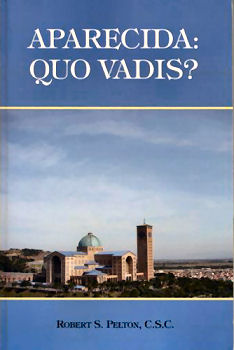
|
Posted September 20, 2010
Book: Aparecida: Quo Vadis? Editor: Robert S. Pelton, C.S.C University of Scranton Press. Chicago Distribution Center, Chicago. 2008. Pp. 229 An Excerpt from the Preface
My essay, “Medellin and Puebla: Dead or Alive in the 21st Century Church?” provides overview and context of the Fifth General Conference. It concludes that Medellin and Puebla are in fact alive because of the achievements of Aparecida. While these achievements provide clear hope for the future, specific challenges remain as the Church works to fulfill her mission. The next two essays focus on the contemporary Catholic Church in the Americas: “The Challenge of Aparecida for the Church in America” by Bishop Ricardo Ramirez, and “Aparecida and Hispanics of the U.S.A.” by Father Virgilio Elizondo. The themes of the next two chapters are essential to understanding the principal objectives of Aparecida: “The Preferential Option for the Poor at Aparecida” (Rev. Gustavo Gutieerez, O.P.), and “Base Communities, A Return to Inductive Methodology” (Rev. Jose Marins). Globalization assumes particular significance at this time in history. Rev. Ernest Bartell, C.S.C provides context for this vital issue in “Aparecida and Global Markets,” Professor Javier Maria Iguiniz Exheverria even more specific in “Globalization and Economics at Aparecida.” The third essay on globalization, “An Analysis of the Aparecida Document in Terms of Structural Sin” by Professor Margaret Pfeil, is one of the most challenging of the series. It describes clearly the seeds of social transformation that we must sow if we are to meet the recommendations of the Aparecida document. Rev. Sergio Torres “Amerindia: Return from Internal Exile” is a fascinating and positive expression of dialogue within the Church, one that could serve as model for other fruitful exchanges between theologians and Church officials in the future. The concluding essays, “Aparecida and Pentecostalism in Latin America” by Rev. Edward L. Cleary, OP, and “The Future as Seen From Aparecida” by Daniel H. Levine, elucidate the challenges remaining for the Catholic Church. We need to consider these challenges carefully, along with reasons for hope, especially those implied in an ongoing and deeper commitment to a preferential option for the poor. An Excerpt from the Book: The principal focus of the documents issued by the bishops at Aparecida is clearly upon the overall pastoral mission of the Church in Latin America, in which economic life is only one of many issues. Therefore, it is not surprising that the updated preferential option for the poor grounds the relatively limited economic portion of the document. Against the background of over two centuries of universal Catholic social teaching, as well as the checkered history of capitalist and socialist regimes and policies in Latin America, the generalized economic observation and recommendations of the bishops at Aparecida may appear somewhat low-keyed. There are no calls for a new “third way” between the poles of extreme capitalist and socialist economic models such as those that characterized sectors of Catholic social thought in the industrial countries of Europe and North America in the last century. Nor are there calls for radical, even revolutionary, overhauls of existing economic systems, such as those proposed by representatives of both the political left and right, which have characterized much of political life in Latin America as well. Instead, in the pastoral spirit of the Aparecida documents, the general but firm observations, descriptions, and prescriptions of moral priorities in economic and political life are offered as measured challenges. No specific economic actors are singled out and targeted as villains, not the multinational corporations targeted by social activists on the left during the middle of the last century nor the inefficient state enterprises targeted more recently by non-governmental agencies like the International Monetary Fund, along with neo-liberal critics. . . .They do so not to propose solutions or pass judgments, but to challenge and exhort all who have responsibilities that influence global economic life. |
|
